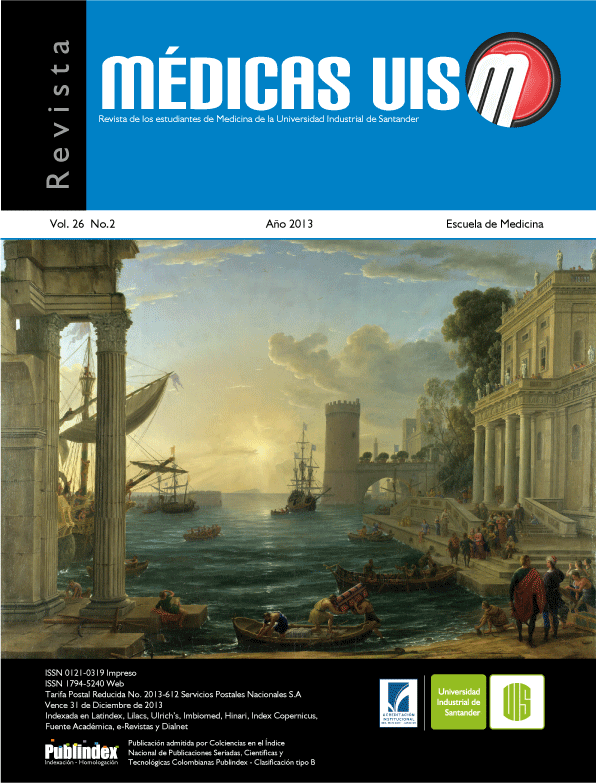Abstract
Objetivo: reportar un caso clínico de fístula biliar secundaria a trauma hepático penetrante dada su baja incidencia, que fue tratado de manera convencional al no contar con colangiopancreatografía retrógrada endoscópica. caso clínico: se presenta un hombre de 28 años de edad, con fístula biliar resultante de trauma hepático penetrante. Discusión: la fuga biliar es una complicación mayor después de cirugía hepática y una complicación poco frecuente después de un trauma hepático mayor. El tratamiento convencional ha consistido en
intervención quirúrgica con debridación hepática, reparación ductal, una fstula controlada y ERCP cuando está disponible. conclusión: la fístula biliar fue tratada exitosamente con manejo conservador, el tiempo entre el trauma hepático y el cierre de la fístula fue de 35 días.
(MÉD.UIS. 2013;26(2):71-3).
References
2. Trunkey DD, Shires GT, Mc Clelland R. Management of liver trauma in 811 consecutive patients. Ann Surg. 1974;179(5):722-8.
3. Terajima H, Ikai I, Hatano E, Uesugi T, Yamamoto Y, Shimahara Y, et al. Effectiveness of endoscopic nasobiliary drainage for postoperative bile leakage after hepatic resection. World J Surg. 2004;28(8):782-6.
4. Vagianos C, Polydorou A, Karatzas T, Vagenas C, Stavropoulos M, Androulakis J. Successful treatment of postoperative external biliary fistula by selective nasobiliary drainage. HPB Surgery. 1992;6:115-24.
5. Grala P, Skrzywanek P, Sowier A. Biliary fistulas resulting from blunt hepatic injury treated by endoscopic diversion of the bile flow. Acta Chir Belg. 2009;109(1):47-51.
6. Enríquez Domínguez L, Castillo Moreno JR, Herrera Ramírez F, Díaz Rosales JD. Trauma hepático por heridas punzocortantes y por arma de fuego. Nuestra experiencia en Ciudad Juárez. Cir Gen. 2011;33(1):21-5.
7. Hollands MJ, Little JM. Post-traumatic bile fistulae. J Trauma. 1991;31(1):117-2
8. Howdieshell TR, Purvis J, Bates WB, Teeslink CR. Biloma and biliary fistula following hepatorraphy for liver trauma: incidence, natural history and management. Am Surg. 1995;61(2):165-8.
9. Hommes M, Kazemier G, Schep N, Kuipers E, Schipper I. Management of biliary complications following damage control surgery for liver trauma. Eur J Trauma Emerg Surg. 2013;39(5):511-6.
10. Del Olmo L, Meroño E, Moreira VF, Garcia T, Garcia Plaza A. Successful treatment of postoperative external biliary fistulas by endoscopic sphincterotomy. Gastrointest Endosc.1988;34(4):307-9.
11. Piper GL, Peitzman AB. Current Management of hepatic trauma. Surg Clin North Am. 2010;90(4):775-85.
